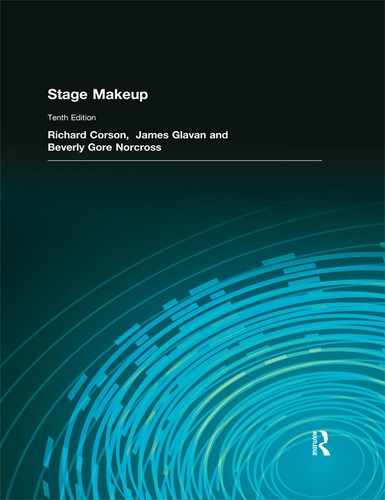Contents
DEDICATION by Mitchell Ericson
FOREWORD by Hal Holbrook
PREFACE
INTRODUCTION by Uta Hagen
ILLUSTRATIONS
Part 1 Basic Principles
CHAPTER 1 Facial Anatomy
Bones of the Face
Construction of a Head
Modeling a Head in Clay
Problems
CHAPTER 2 Light and Shade
Flat and Curved Surfaces
Hard and Soft Edges
Drawing with Highlights and Shadows
Problems
CHAPTER 3 Color in Pigment
Characteristics of Color
Color Mixing
Problems
CHAPTER 4 Lighting and Makeup
Color in Light
Light on Pigment
Direction of Light and Its Effect on Facial Features
Problems
Part 2 Planning the Makeup
CHAPTER 5 Relating the Makeup to the Character
Character Analysis
Heredity
Race
Environment
Temperament
Health
Age
Physiognomy
Problems
CHAPTER 6 Designing the Makeup
The Makeup Designer
The Actor as Designer
Costume Designer’s Influence on the Makeup Design
Sketches and Drawings
Adapting the Makeup to the Actor
Quick Changes
Working Drawings
Worksheets
Problems
Part 3 Applying the Makeup
CHAPTER 7 Makeup Equipment
The Makeup Kit
The Makeup Room
The Makeup Workshop
The Makeup Morgue
Problem
CHAPTER 8 Applying Makeup
Liquid Makeup
Creme Makeup
Face Powder
Cake Makeup
Dry Makeup
Mascara
Lip Color
Concealers, Neutralizers, and Tattoo Covers
Appliance Makeup
Airbrush Cosmetics
Mixed Techniques
CHAPTER 9 Corrective Makeup
The Foundation
Facial Analysis
Forehead
Nose
Jaw Line and Chin
Wrinkles
Eyes
Eyeshadow
Eyebrows
Cheeks
Lips
Neck
Teeth
Hair
Problems
CHAPTER 10 Stippling
Stippling with Sponges
Stippling with Brushes
Stippling for Texture
Stippling to Reduce Contrasts
Stippling to Add Color
Stippling to Conceal Edges
CHAPTER 11 Modeling with Highlights and Shadows
Modeling Hard and Soft Edges
Modeling the Face and the Neck
Foundation Colors
Highlight Colors
Shadow Colors
Area 1: Forehead
Area 2: Eyes
Eyebrows
Area 3: Nose
Area 4: Cheeks
Nasolabial Folds
Jawline
Area 5: Mouth and Chin
Neck
Hands
Teeth
Reshaping the Face
Bringing the Makeup to Life
Problems
CHAPTER 12 Three-Dimensional Makeup
Nose Putty
Derma Wax
Putty-Wax
Silicone Putty
Gelatin
Latex
Plastic Film
Old Age Stipple
Latex and Tissue
Spirit Gum, Tissue, and Latex
Latex, Cotton, and Spirit Gum
Cornmeal, Wheat Germ, or Bran with Latex and Spirit Gum
Special Constructions
Problems
CHAPTER 13 Prosthetic Makeup
(with substantial contributions from Dick Smith, Matthew Mungle, and John McFall)
Casting for Prosthetics
Prosthetic Pieces
Application of Prosthetic Pieces
Foam Latex
Painting Foam Latex
Cold-Foam Process
Silicone Foam
Foam Gelatin
Teeth
Advanced Mold Making
Making a Gelatin Wrap-around Appliance
Applying Gelatin Appliances
Silicones
Problems
CHAPTER 14 Beards and Mustaches
Crepe Hair
Preparation of Crepe Hair
Mixing Colors
Application of Crepe Hair
Beard Stubble
Eyebrows
Ventilated Pieces
Construction of Ventilated Pieces
Application of Ventilated Pieces
Dressing Ventilated Pieces
Removing and Cleaning Ventilated Pieces
Adapting Beards
Problems
CHAPTER 15 Hair and Wigs
(with a substantial contribution from Amanda French)
Natural Hair
Wigs and Hairpieces
Measuring for Wigs
Selecting Wigs
Styling Wigs
Falls and Chignons
Cleaning Wigs
Adding a Natural Hairline
Putting on and Securing a Wig
Removing the Wig
Problems
CHAPTER 16 Creating a Likeness
Queen Elizabeth I
Mark Twain
Stalin and Trotsky
The Mad Hatter
Problems
CHAPTER 17 Natural Makeup for Film and Television
(with substantial contributions from Joe Rossi, Tobi Britton, Sheila McKenna, and Gordon Espinet)
High-Definition Digital Technology
Choosing a Foundation
Natural Makeup for the Female Performer
Makeup for the Male Performer
Working with a Makeup Artist
Conclusion
Problems
CHAPTER 18 Makeup for Darker Skin Tones
by Marietta Carter-Narcisse
Determining Undertones
Choosing a Foundation
Concealers, Highlighters, and Neutralizers
Contouring
Powder
Blush
Eyeshadow
Lip Color
Adhesives
Lighting
Skin Types and Skin Conditions
The Basic Makeup Kit
Problems
CHAPTER 19 Nonrealistic Makeup
Nonrealistic Styles
Nonrealistic and Nonhuman Characters
Problems
Part 4 The Appendices
APPENDIX A Makeup Materials
APPENDIX B Sources of Makeup Materials
APPENDIX C Contents of a Professional Makeup Kit
APPENDIX D Health and Safety
by Monona Rossol
Lead and Mercury
Hazards to Wearers
Hazards to Makeup Artists
How We Are Exposed
Skin Diseases
Eye Diseases
Infections Transmitted
Label Reading Tips
Cosmetic Ingredients
Special Effect Makeups
When Skin Trouble Strikes
General Rules for Makeup Users
Additional Precautions for Makeup Artists
APPENDIX E Fashions in Makeup
Ancient Peoples
The Middle Ages
The Sixteenth Century
The Seventeenth Century
The Eighteenth Century
The Nineteenth Century
The Twentieth Century
APPENDIX F Fashions in Hair
APPENDIX G Makeups in Color
CONCLUSION
INDEX
